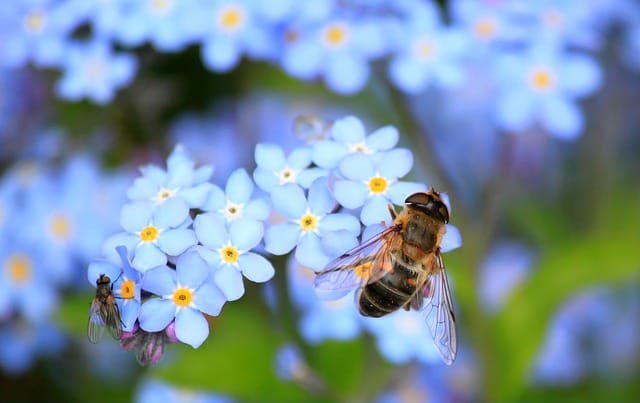How to grow Forget-Me-Nots
Forget-Me-Nots (Myosotis) are delightful and charming flowers that can add a touch of beauty to any garden

In this article:
- Introduction
- Overview of Forget-Me-Nots
- Choosing the Right Location
- Soil Preparation and Planting
- Watering and Fertilizing
- Providing Adequate Sunlight
- Pruning and Deadheading
- Preventing and Managing Pest and Disease Issues
- Propagation Techniques
- Winter Care and Protection
- Tips for Creating a Forget-Me-Not Garden
- Frequently Asked Questions (FAQs)
- Conclusion
Introduction
Forget-Me-Nots (Myosotis) are delightful and charming flowers that can add a touch of beauty to any garden. With their delicate blue blooms and enchanting meaning, forget-me-nots have become a popular choice for many garden enthusiasts. This article provides a comprehensive guide on how to grow and care for these lovely flowers.
Overview of Forget-Me-Nots
Forget-Me-Nots are perennial flowers that belong to the Boraginaceae family. They are native to Europe and thrive in cool, temperate climates. These plants typically have clusters of small, five-petaled flowers that come in shades of blue, pink, or white. Forget-me-nots grow between 6 and 24 inches tall, depending on the variety.
Choosing the Right Location
Forget-me-nots prefer partial shade to full sun, making them ideal for planting under trees or on the north side of your garden. It is essential to select a location that receives shade during the hot afternoon hours, especially in warmer climates. These flowers also prefer moist soil, so planting them near a water source or in a damp area is beneficial.
Soil Preparation and Planting
Prepare the soil before planting forget-me-nots by removing weeds and loosening it with a garden fork or tiller. Add organic matter, like compost or well-rotted manure, to improve drainage and fertility. Plant forget-me-nots in early spring or fall, spacing them about 6 to 12 inches apart, depending on the variety. Dig a hole slightly larger than the plant's root ball, place the plant in the hole, and backfill with soil. Gently pat down the soil around the plant and water thoroughly.
Watering and Fertilizing
Forget-me-nots require consistent moisture to thrive. Water the plants regularly, aiming for about an inch of water per week. During hot and dry periods, you may need to water more frequently. Avoid overwatering, as it can lead to root rot. Apply a balanced fertilizer once every four to six weeks during the growing season to promote healthy growth and abundant blooms.
Providing Adequate Sunlight
Forget-me-nots perform best in partial shade, receiving about four to six hours of sunlight a day. However, they can tolerate full sun in cooler climates. If planting in a sunny location, make sure the soil remains consistently moist to prevent the plants from drying out.
Pruning and Deadheading
Regular pruning and deadheading can help prolong the blooming period of forget-me-nots. Deadhead the flowers by removing faded blooms to encourage more blossoms. After the plants have finished flowering, cut back the entire plant to about half its height to promote bushier growth and prevent self-seeding.
Preventing and Managing Pest and Disease Issues
Forget-me-nots are generally resistant to pests and diseases. However, they can occasionally suffer from aphid infestations or powdery mildew. To control aphids, rinse the plants with a strong jet of water or use insecticidal soap. If powdery mildew appears, remove the affected leaves and treat the plant with a fungicidal spray.
Propagation Techniques
Forget-me-nots can be propagated through division or seed. Division is best done in early spring or fall by carefully separating the plant's root ball and replanting the divisions. To grow from seed, sow them directly in the garden in early spring or late summer. Lightly cover the seeds with soil and keep the area consistently moist until germination occurs.
Winter Care and Protection
In areas with harsh winters, forget-me-nots may need some protection to survive. Apply a layer of mulch around the plants in late fall to help insulate the soil and protect the roots from freezing. Mulching also helps retain moisture during winter. If heavy snowfall occurs, gently brush off the snow from the plants to prevent damage.
Tips for Creating a Forget-Me-Not Garden
- Combine forget-me-nots with other spring-blooming flowers, such as tulips or daffodils, for a stunning display.
- Create a natural-looking garden by allowing forget-me-nots to self-seed and spread freely.
- Plant forget-me-nots near water features or along streams to mimic their native habitat.
- Consider growing forget-me-nots in containers or hanging baskets for small spaces or balconies.
- Choose different forget-me-not varieties to enjoy a variety of flower colors and sizes in your garden.
Frequently Asked Questions (FAQs)
Q: Are forget-me-nots deer resistant?
A: Forget-me-nots are generally not favored by deer, making them a good choice for deer-prone areas.
Q: Can forget-me-nots be grown indoors?
A: Although forget-me-nots are primarily outdoor plants, they can be grown indoors in containers if provided with adequate sunlight and moisture.
Q: How long do forget-me-not flowers typically last?
A: Forget-me-not flowers usually last for about two to four weeks, depending on growing conditions and the specific variety.
Conclusion
With their delicate blooms and rich symbolism, forget-me-nots are a beautiful addition to any garden. By following the tips and guidelines provided in this article, you can successfully grow and care for these charming flowers. Whether you choose to plant them in borders, rock gardens, or containers, forget-me-nots will surely bring joy and a touch of nostalgia to your outdoor space.
